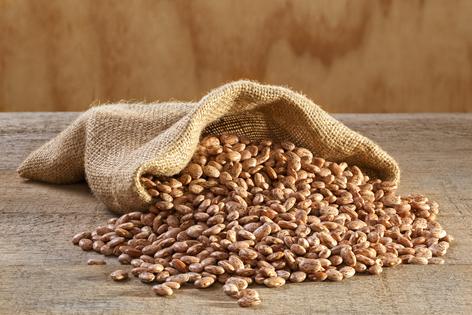Are pinto beans healthy? Here’s what a dietitian has to say
Published in Health & Fitness
Like other bean varieties, pinto beans are a plant-based protein that adds flavor, texture and color to an array of dishes. What might surprise you is that pinto beans are the most popular type of beans eaten by Americans, claiming the top spot among all the bean varieties.
What are pinto beans?
Pinto beans are tan-colored, oval-shaped beans with specks of reddish-brown. Metaphorically, each pinto bean resembles a painting, and in Spanish “pinto” means painted. Pinto beans are a staple in Mexican and Southwestern American cuisine. The beans are soft, creamy, nutty and earthy, making them perfect for burritos, fajitas, tacos, quesadillas.
Are pinto beans healthy?
Pinto beans are highly nutritious, and research suggests that eating them may help provide protection against many chronic illnesses. They are gluten- and cholesterol-free and are rich in protein, fiber and folate. Pinto beans also have essential nutrients such as iron, magnesium, thiamin, calcium and zinc. They are low in fat and sodium when they are prepared without any salt and additives.
Health benefits of pinto beans
Excellent plant-based protein source: Every 1/2-cup serving of cooked pinto beans provides 8 grams of protein. However, pinto beans are not a complete protein, meaning that they do not contain all the essential amino acids which the body needs. Vegetarians and vegans will need to eat a variety of plant-based foods, such as whole grains, nuts and seeds, to ensure that they obtain all the essential amino acids.
High in fiber: Every 1/2-cup serving also provides 8 grams of dietary fiber, which can keep you feeling fuller longer. Fiber-rich foods can also help improve heart health, digestive health, cholesterol, weight maintenance and more.
Low-glycemic food: While pinto beans contain carbohydrates, they do not raise blood sugar quickly because they are slowly digested and absorbed. For this reason, pinto beans are considered a low-glycemic food.
Rich in folate: Pinto beans are an excellent source of folate, with every 1/2-cup serving providing more than one-third of your daily recommended intake. Folate is essential for making cells, tissues and red blood cells in the body, as well as preventing neural tube defects in the early stages of pregnancy.
Loaded with antioxidants: Beans have bioactive compounds, such as flavonoids, which are believed to act as antioxidants. Pinto beans are particularly rich in kaempferol, one of the many antioxidants present in plant-based foods. Kaempferol has properties that may effectively reduce inflammation and protect cells against free radicals, which can reduce risk of cancer.
Potential drawbacks of pinto beans
Lack of vitamin B12: Pinto beans do not contain any vitamin B12, an essential nutrient for the brain and nerves and for making red blood cells and supporting DNA production.
Gas and bloating: Eating beans may bring discomfort to some people. This is due to raffinose, a type of carbohydrate that does not get digested. If you are sensitive to gas and bloating, consider soaking dry beans overnight. Doing so may help reduce the amount of raffinose present.
How to enjoy pinto beans
You can enjoy them in many ways: as a side dish or as a protein for a meatless meal. You can also use them in soups or add them to salads, stews, rice dishes and more. Because of their soft texture, pinto beans are also perfect for dips, spreads and fillings.
(EatingWell is a magazine and website devoted to healthy eating as a way of life. Online at www.eatingwell.com.)
©2023 Dotdash Meredith. All rights reserved. Used with permission. Distributed by Tribune Content Agency, LLC.







Comments